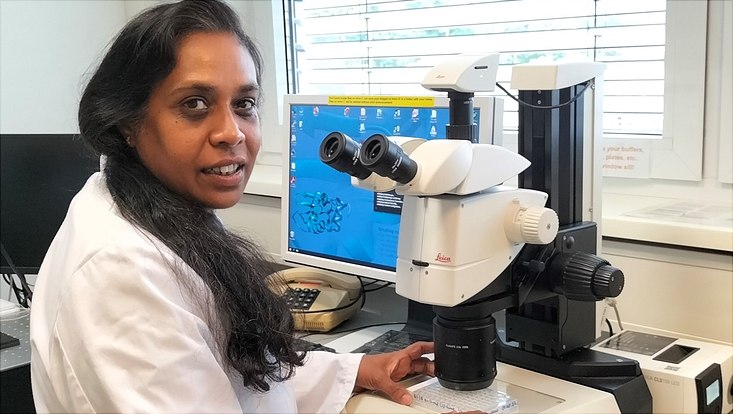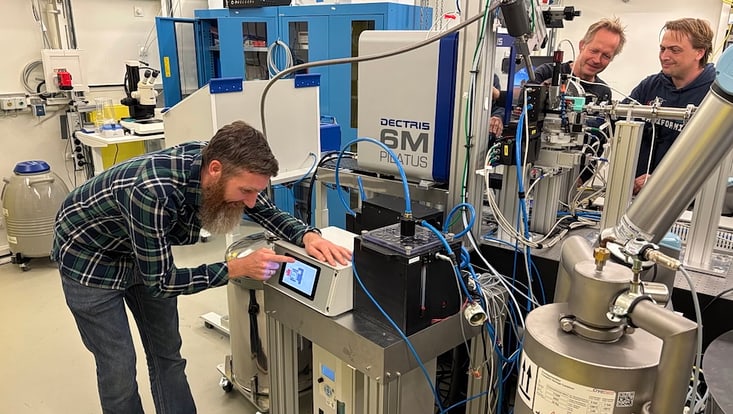Imaging of Matter
Researchers discover natural compounds against coronavirus
18 August 2022

Photo: UHH/Gevorgyan
Scientists at Universität Hamburg and DESY have identified three compounds that are promising candidates for drug development against coronavirus. All three are already used as active ingredients in existing drugs, the team reports in the journal "Communications Biology".
The team, led by Prof. Christian Betzel of Universität Hamburg and Dr. Alke Meents of DESY, subjected a large natural product library to extensive screening. “We tested 500 substances from the Karachi Library of Natural Compounds if they bind to the papain-like protease of the novel coronavirus, which is one of the main targets for an antiviral drug,” explains the study's main author Dr. Vasundara Srinivasan from Universität Hamburg. “A compound that binds to the enzyme at the right place can stop it from working.”
The Papain-like protease (PLpro) is a vital enzyme for virus replication. When the coronavirus hijacks a cell, it forces it to produce building blocks for new virus particles: Proteins that are produced in the form of a long chain. PLpro then acts like a molecular pair of scissors and cuts this chain into individual pieces. If this process is blocked, no new virus particles can be produced.
For the experiments, PLpro was mixed with each of the 500 natural substances, giving them the chance to bind to the enzyme. However, a conventional microscope cannot be used to determine whether a substance binds to the enzyme. That is why tiny crystals were grown from the mixtures. In the bright X-rays of the PETRA III particle accelerator at DESY, these crystals produced a characteristic diffraction pattern from which the structure of the enzyme could be reconstructed down to the level of individual atoms. "From this information, we can produce three-dimensional models of the enzyme with atomic resolution and see if and where a substance binds to it," Dr. Meents explains.
Three substances were actually able to bind the enzyme: Hydroxyethylphenol (YRL), which was isolated from the henna tree Lawsonia alba and is also found in red wine and olive oil. It is used as a remedy for cardiac arrhythmias. Hydroxybenzaldehyde (HBA) was isolated from the copper leaf Acalypha torta and is a known antitumor agent. Methyl dihydroxybenzoate (HE9), isolated from the French marigold Tagetes patula, has anti-inflammatory effects and is found in green tea. In laboratory tests, these substances slowed the activity of PLpro in living cells by 50 to 70 percent.
“The advantage of these substances is their proven safety,” says Betzel, who is also a member of the cluster of excellence CUI: Advanced Imaging of Matter at Universität Hamburg. “These compounds naturally occur in many foods. However, drinking green tea will not cure your corona infection! Like it will not heal your wounds or cure your cancer. If and how a corona drug can be developed from these phenols is subject to further studies.”
The study involved researchers from Universität Hamburg, the University of Sao Paulo in Brazil, the Diamond Light Source in the United Kingdom, the European X-ray laser European XFEL, Bahauddin Zakariya University in Pakistan, Hospital Israelita Albert Einstein in Brazil, Scientific Platform Pasteur in Brazil, the European Molecular Biology Laboratory in Hamburg, the Fraunhofer Institute for Translational Medicine and Pharmacology in Hamburg, the Jozef Stefan Institute in Slovenia, the Centre of Excellence for Integrated Approaches in Chemistry and Biology of Proteins in Slovenia, the University of Greifswald and DESY are involved. Text: UHH
More information:
DESY news article, including an animation that illustrates the principles of this research using the example of the coronavirus' main protease Mpro.
Reference:
Vasundara Srinivasan et al.
"Antiviral activity of natural phenolic compounds in complex at an allosteric site of SARS-CoV-2 papain-like protease"
Communications Biology, 2022


